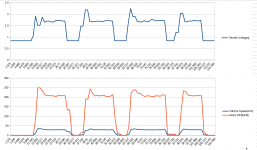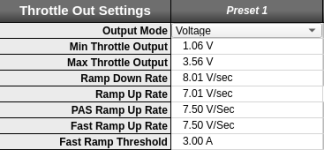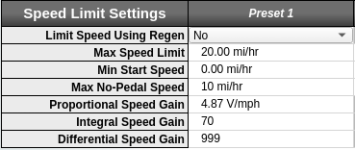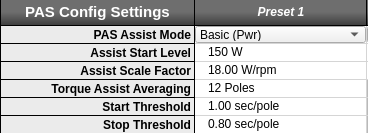pickworthi
100 W
<preamble>
I have replaced my previous KT style controller with a CA3 and Baserunner Z9. At the same time I got a 24 pole PAS sensor from Grin.
All wired connections are good, and everything functions as intended.
The bike is used for PAS only, and I want it to be UK street legal, so 16mph max assist speed.
Its a 36v (10S) battery system. Batteries have been built and tested by me, up to 18 amps continuous discharge.
Based on measurements I have taken from the previous system, the motor (a generic Shengyi - thread here: https://endless-sphere.com/forums/viewtopic.php?f=30&t=112495 has adjustments I thought were needed) is happy at a maxim of 500W. So that is what I have set the maximum power in the CA to. The motor provides a single pole speed sensor via the Baserunner (weird thing to cheap out on - but there it is).
I set the PAS to power mode, max start 500W, zero RPM gain (I pedal at 85-95RPM, so no use for RPM adjustment). Throttle is set to OFF mode.
I adjusted WGain down to 9 to get rid of rough sound when near full power.
I set maxSpeed to 21mph, and use the Digital Aux to scale it down to the desired 16mph (or less for trails).
All throttle ramp up/down settings are at the CA defaults (except that I made PAS the same as throttle, since no throttle).
I have left the Baserunner torque ramp up interval at 200ms (the default).
</preamble>
Unfortunately, I have one problem that I just can't get a handle on - all related to max speed limiting at 16mph:
- Using the default CA settings (PSGain=1.01, ISGain=30, DSGain=300) the bike accelerates at full power (500W) all the way to 20ish MPH, and then very slowly lets the power off until the speed drops to around 15mph. It will only finally settle at 16mph if I am on a reasonable incline where around 200W is required to maintain speed. Example: when coasting on a downhill, the CA powers at 500W if I start pedalling when speed is 20mph, and takes a while to realise it is WAY over the limit.
- If I use the Digital Aux to limit the maximum speed to lower than 16mph, I get a fairly consistent 4mph overshot with the behaviour as above.
I have spent many hours studying the advice in the CA unofficial guide, and also the GRIN tech pages for the CA3. I first tried adjusting around the CA default settings for the PID loop, with no success. Actually I mostly could just make it worse. (I tried single change at a time - reducing PSgain, and ISGAin - trying to get the over damped behaviour.)
Today I spent 4 hours riding up and down a flatish piece of road, trying to implement the CA Unofficial Guide Appendix F process.
What I find is that a PSGAin setting that produces "a single modest overshoot occurs before the speed settles" appears impossible. I either get a very sluggish, over damped, low power (<100W) progression to about 11-12mph, or a full 500W progression to 20ish mph. The difference between the two is just 0.01 in the PSGain setting. (IS=1 & DS=0 in Appendix F).
At this point I am assuming that there is something else in the system that is making it so unforgiving.
I really want to achieve the behaviour as stated in the GRIN tech manual: "A 3 term PID control algorithm is employed in firmware to enable a smooth rollback of motor power as target speed is reached without oscillation."
If anyone can provide some suggestions as how to achieve a "modest overshoot" I would be eternally grateful.
I have replaced my previous KT style controller with a CA3 and Baserunner Z9. At the same time I got a 24 pole PAS sensor from Grin.
All wired connections are good, and everything functions as intended.
The bike is used for PAS only, and I want it to be UK street legal, so 16mph max assist speed.
Its a 36v (10S) battery system. Batteries have been built and tested by me, up to 18 amps continuous discharge.
Based on measurements I have taken from the previous system, the motor (a generic Shengyi - thread here: https://endless-sphere.com/forums/viewtopic.php?f=30&t=112495 has adjustments I thought were needed) is happy at a maxim of 500W. So that is what I have set the maximum power in the CA to. The motor provides a single pole speed sensor via the Baserunner (weird thing to cheap out on - but there it is).
I set the PAS to power mode, max start 500W, zero RPM gain (I pedal at 85-95RPM, so no use for RPM adjustment). Throttle is set to OFF mode.
I adjusted WGain down to 9 to get rid of rough sound when near full power.
I set maxSpeed to 21mph, and use the Digital Aux to scale it down to the desired 16mph (or less for trails).
All throttle ramp up/down settings are at the CA defaults (except that I made PAS the same as throttle, since no throttle).
I have left the Baserunner torque ramp up interval at 200ms (the default).
</preamble>
Unfortunately, I have one problem that I just can't get a handle on - all related to max speed limiting at 16mph:
- Using the default CA settings (PSGain=1.01, ISGain=30, DSGain=300) the bike accelerates at full power (500W) all the way to 20ish MPH, and then very slowly lets the power off until the speed drops to around 15mph. It will only finally settle at 16mph if I am on a reasonable incline where around 200W is required to maintain speed. Example: when coasting on a downhill, the CA powers at 500W if I start pedalling when speed is 20mph, and takes a while to realise it is WAY over the limit.
- If I use the Digital Aux to limit the maximum speed to lower than 16mph, I get a fairly consistent 4mph overshot with the behaviour as above.
I have spent many hours studying the advice in the CA unofficial guide, and also the GRIN tech pages for the CA3. I first tried adjusting around the CA default settings for the PID loop, with no success. Actually I mostly could just make it worse. (I tried single change at a time - reducing PSgain, and ISGAin - trying to get the over damped behaviour.)
Today I spent 4 hours riding up and down a flatish piece of road, trying to implement the CA Unofficial Guide Appendix F process.
What I find is that a PSGAin setting that produces "a single modest overshoot occurs before the speed settles" appears impossible. I either get a very sluggish, over damped, low power (<100W) progression to about 11-12mph, or a full 500W progression to 20ish mph. The difference between the two is just 0.01 in the PSGain setting. (IS=1 & DS=0 in Appendix F).
At this point I am assuming that there is something else in the system that is making it so unforgiving.
I really want to achieve the behaviour as stated in the GRIN tech manual: "A 3 term PID control algorithm is employed in firmware to enable a smooth rollback of motor power as target speed is reached without oscillation."
If anyone can provide some suggestions as how to achieve a "modest overshoot" I would be eternally grateful.




















